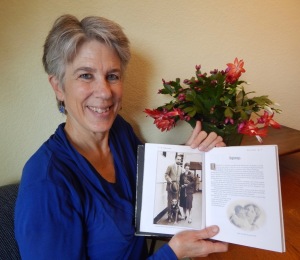We interrupt this series on our experiences under COVID-19 to bring you more apocalypse. The following is adapted from a note sent to former members of the Association of Personal Historians, who have stayed in touch since its closure. Members on the West Coast were asked to check in and let us know how they were faring as fires raged. This is Trena’s response from September 16, 2020.
By Trena Cleland
Last Monday night, Robert and I rode our bikes to a friendly Labor Day block party in a nearby neighborhood. There were musicians jamming, vendors selling boho-chic items such as pottery and jewelry, and a group of young girls making balloon animals for $1 each.
Weirdly, at about 8 p.m., it started smelling like a smoky campground. Oh, and look — there’s gray smoke coming over the trees way down the block. Whaaahhh? Like fog rolling in, the party turned from warm and summery to dusk/smoke.
It’s been like a nuclear winter since then — thick, dense smoke — with only infrequent dashes outside to pick a tomato or buy groceries. Each time, you come back smelling like you’ve been hanging out in an ashtray, and have to wash off the soot. I don’t like to touch anything outside — forget about the coronavirus, I’m talking about the dirty ash on the garden plants and the car door handle. N95 masks are de rigeur, not the pretty cloth masks that are my everyday pandemic wear. (I can’t believe I miss them!)

NASA image courtesy of the NASA/Goddard Space Flight Center Earth Science Data and Information System (ESDIS) project.
Fire-wise, we are well out of harm’s way, and feel very fortunate. The closest fire, the Holiday Farm fire, is about 30 miles east of us. Sadly, it is right along the forested wonderland/playground of the spectacular McKenzie River. Some small hamlets have been destroyed, along with magnificent nature. Someone forwarded a poem that says, “Do not forget that the ashes falling from the sky are all that remains of the pine and grass and thistle and bear and coyote and deer and mouse that could not escape.”
Not to mention that the smoke, while mostly trees, contains some percentage of immolated cars, buildings, tires, fuel, even burnt-up Christmas ornaments from Christmas Treasures, a year-round holiday store.
The Air Quality Index number in our neighborhood has routinely been above 500, which is the highest number on the AQI chart. 500 is beyond ‘very unhealthy,’ it’s ‘ hazardous.’ So, what’s beyond hazardous? Something tells me, if you have to ask, you’re already dead.
Robert wrote the following:
We are at day six of the epic Eugene smoke-in. As of today, the Holiday Farm fire is 6% contained. The slow progress is mainly due to highly inaccessible terrain, and an under-staffing of fire fighters. The fire is mostly burning on north and south fronts. The eastward and westward progression is minimal, which is really good because the cities of Eugene/Springfield lie due west of the fire location.
Our tap water now has a distinct ashy off-flavor. Our water supply is the McKenzie River, and it is the McKenzie watershed which is burning. EWEB (our local water and electric utility) has water and hydroelectric plants potentially in harm’s way, but so far, no imminent threat. Some good fire news, the historic Goodpasture wooden covered bridge, at the Leaburg reservoir, was saved from the flames.
For now, we are sheltering in place — a lockdown within a lockdown. What these last six days have reminded me most of are the ‘snow days’ of youth, when heavy Midwestern snowfall kept us home from school. Rob and I have baked, done arts and crafts, played Scrabble, and watched documentaries. The hope is that either wind and/or rain will arrive by Wednesday or Thursday to move away this dense fog of impenetrable smoke.
We’re so fortunate to have a well-insulated house, with good air circulation. Eugene also has many folks who camp out in parks and along the river year-round, and that’s just unimaginable, to think about their 24/7 immersion in smoke.
We already surmised that the COVID pandemic would lead to more homelessness, poverty, mental and physical illness, and closed businesses; and these fires will only amplify those trends up and down the West Coast. A cousin of Rob’s lost her home in the Boulder Creek fire near Santa Cruz about three weeks ago. Welcome to the rest of our lives, living with the impacts of this world-gone-awry.
Despite the gloomy feelings, I accept that the world is unfolding as it will, for reasons outside my understanding. World history is full of plagues and cataclysms, and it seems logical that our time should be no exception. Soon the fires will stop and the sun will be revealed and the air will clear up, as it always has. The wheel of life keeps turning around and around.
So, we’re trying to stay positive and keepin’ the faith, and are very grateful for our comfort and abundance.
On Thursday, September 18th, the rain came.

Trena Cleland, personal historian in Eugene, Oregon, with one of her books.
© 2020 Trena Cleland
Trena Cleland started her personal history business in 1998, and joined Association of Personal Historians that year. She has produced dozens of heirloom memoir books based on oral history interviews and coordinated many smaller legacy projects. She has also volunteered her time on several community history projects, documenting the lives of homeless seniors and women with HIV. She now lives and works in Eugene, Oregon. www.trenacleland.com
